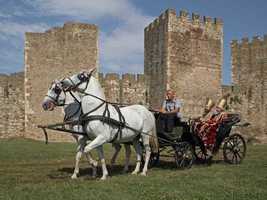
The first town downstream from Belgrade, Smederevo is set in a place where the waters of the Danube reflect the sunrays on the hillsides covered in orchards and vineyards, the sight that inspired the Romans to call area Mons Aureus - Golden Hill. Modern Smederevo is a large industrial center and has lost a lot of its connection with the pastoral beauties surrounding it. The first reference to Smederevo dates back to 1019 as one of the bishoprics of the newly established Ohrid Archbishopric. The city gained in importance in 15th c. when the center of the Serbian states was shifting north ahead of the Turkish attacks. In 1427, after the death of despots Djuradj Branković, acting on a previously prepared agreement, handed over Belgrade to the Hungarian King. Left without the capital and the strongest of his forts, Djuradj turned his attention to the immediate construction of a new fort to become the Serbian capital. He opted for Smederevo, a site protected by the Danube River and the Jezava stream. The Smederevo fortress is the biggest in Serbia and one of the largest in Europe. The central town square - Trg Republike, dominated by the large Church of St George. It was built in 1851-55 by the renowned Andreja Damjanov of Macedonia. Next to the church stands the memorial to the soldiers fallen in 1912-18 wars. An atypical sight for a center of a large town is the so-called Karadjordjev's mulberry an estimated 300 years old tree standing as a centerpiece of a small square. Underneath this - at the time already ancient - tree in 1805 the leader of Serbian insurrectionists Karadjordje received the keys of town from the surrendering Turkish commander.
To receive our best monthly deals
JOIN THE NEWSLETTER
